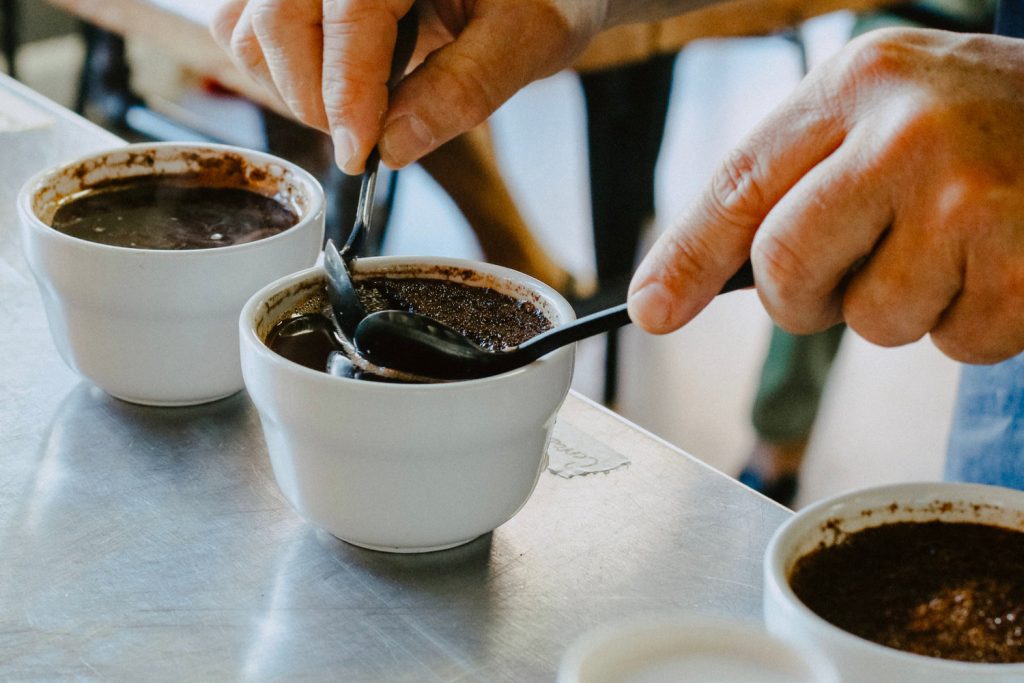The term Specialty coffee refers to a whole new level of quality in your cup. It’s grown, harvested and cared for with a holistic approach.
Speciality roasters keep supply chains short and buy directly from farmers or via ethical importers. This gives more back to the farmers – and ensures that your beans are fresh!
Origins
Speciality coffee is a premium grade of coffee which must fulfil a series of demanding standards from growing, harvesting and processing through to roasting and preparation. It must also be a single-origin coffee, meaning that it has come from a specific region or farm, with the taste and flavour reflecting those origins. It must be certified by the SCA (Speciality Coffee Association) in order to meet their high-end standards and be sold as a specialty coffee.
The world’s best specialty coffees are grown by small-scale artisan producers, and these people take great care in their craft. They might grow their own beans, or they may buy them from ethical importers who work directly with the farmers in the countries of origin. This keeps supply chains short, and means that more of the money spent on the coffee ends up in the hands of the farmers themselves. An example is Two Chimps Coffee, who pay their farmers between 30 and 150% more than the ‘going rate’ for their speciality coffee, giving them enough to invest in their future and provide their families with a decent standard of living.
As well as paying the farmers more, specialty coffee producers must take care when picking their beans. This is done by hand rather than by machine, and the workers only pick ripe red berries. This is a far more labour-intensive process than commodity farming, which is why the prices of specialty coffees are so much higher.
There are a number of different ways that the beans can be processed and dried, but they must be carefully selected to produce the best results. The most common way is to roast and grind the beans, which creates a ready-to-drink product. The second method is to dry the beans on raised beds, where the berries are gently turned and soaked in water. This prevents them from moulding and adds to the flavour of the finished product.
The final method is to dry the berries in the sun, which gives a unique flavour and also preserves some of the natural oils in the beans. The key to good quality is the sourcing of the beans, as a bad source will ruin the end result. Commercial coffee is often sourced from multiple markets in order to drive costs down, but this can lead to poor working conditions and average quality control.
Roasting
In general, speciality coffee is roasted less than commercial grade (which instant coffee is). This means that the flavours are allowed to really develop, as opposed to being masked by burnt and bitterness.
However, that is just one part of the story – speciality roasters aren’t afraid to experiment. They are able to fine-tune their recipes for each type of bean, bringing out subtle flavours like blueberries, milk chocolate and even mangoes. This is all thanks to their careful handling of the beans from harvesting to brewing, and the attention to detail that they apply throughout the process.
The next step is the roasting, and it’s here that the differences between speciality and commodity coffee are really noticeable. While industrial roasters churn out a lot of bland blends, speciality coffee is roasted to bring out the best of each variety. This is a complex task, and it requires a great deal of knowledge about the beans, the climate and the roasting process. Many speciality roasters are independent and have spent hours gaining the necessary skills to understand their product in detail.
Once the beans are roasted, they need to cool down before being packaged for sale. During this stage, the coffee goes through a phase called the “first crack”, which is an exothermic reaction that causes the outside of the bean to heat up faster than the inside. This is when the bean starts to break down, and the smell is reminiscent of popcorn. The roaster then turns the machine off, allowing the beans to cool down slowly and be packaged for sale.
One of the other big differences between speciality and commodity coffee is how the cherries are harvested. Rather than being stripped from the tree, speciality coffee cherries are hand-picked to ensure that only ripe berries are used. This is a much more labour-intensive and expensive process, but it ensures that the full potential of each batch is realized. Many speciality coffees are also grown in shady conditions, which slows down the growth rate and gives the beans more time to develop their natural sugars and flavours.
Brewing
Choosing to serve coffee that’s crafted using speciality methods and practices is a great way for your customers to enjoy your beverage in the finest of fashions. By making the most of these finer details, you can create a wide variety of coffee drinks – from cappuccinos and lattes to breves and mochas. In addition to this, you can use the knowledge and expertise of your staff to help educate your customers on how to get the best results from their favourite drink.
Speciality coffee is defined by stringent quality checks all the way down the supply chain, so that only the highest quality beans are used to make your brew. This is in contrast to commercial coffee which tends to be processed with little care, resulting in an acidic and bitter taste.
The difference between the two starts with the farmers who grow and harvest your coffee beans. Specialty coffee comes from coffea arabica trees, which produce far more flavourful beans than the low-quality robusta varieties used in commodity grade coffee. Speciality beans are also more resilient while growing, so they can be harvested with less damage and a higher percentage of ripe berries.
Commercial coffee is typically grown with the aid of chemical fertilisers and pesticides, but speciality producers favour natural methods that are gentle on their plants. They also tend to use shade growing, which means that their beans are grown beneath the canopy of tall tropical trees rather than in direct sun. This slows down the growing rate and gives your beans a chance to develop naturally sweet, vibrant flavours.
Roasting is another step that sets speciality coffee apart from its commercial counterpart, with the specialised techniques used in the process bringing out the best of each bean’s qualities. It’s the nuances in each coffee that really make it stand out, with subtle tastes like berries, milk chocolate, honey and mangoes all brought to life by these finely-honed techniques.
While speciality coffee may cost a little more than its mass-produced counterpart, it gives a lot back to the farmers who work so hard to grow it for us. The majority of specialty coffee importers and small roasteries support the coffee-growing communities by paying them fair prices for their crop, and some even go as far as trading directly with farms to ensure that these high standards are met.
Taste
The difference between regular coffee and speciality coffee is reflected in the taste of it. The combination of gentle growing, hand-picking and loving, small-batch roasting delivers a vibrant coffee with unique flavour notes that you just won’t find in your average instant blend. Speciality coffee is also planet-kind, with processes like shade growing reducing the deforestation of tall trees and allowing for slow growth so that the fruit can fully ripen.
It’s easy to get overwhelmed with all the different ways that coffee can be described but a good place to start is by looking at the five basic tastes: sweet, sour, bitter, salty and umami (also known as savory). Try and focus on the presence of these flavours as you sip your cup of coffee. If you haven’t mastered them yet, don’t worry! Your daily morning cup of coffee gives you a perfect opportunity to practice.
This first coffee was a real favourite for some of the judges who all agreed that it had a chocolatey aroma and a nice smooth finish. However, it also split opinions – some found the taste a little too jammy and some thought that it had a bitter, burnt taste.
Despite the fact that this was the lowest scoring coffee for all the judges, some found it to be their favourite – possibly because it was the most reminiscent of a traditional commercial coffee that they were used to drinking. The majority of the judges were able to pick up some sweetness and fruitiness in this coffee but they all agreed that it was a little too heavy for them.
Most of the judges were able to pick up a nutty, citrus flavour in this coffee and some also thought that it was smooth and mellow. Others felt that it was a little too fruity and that it was similar to marmite in taste. Several people commented that this coffee had very little smell and that any that was there was quite weak. It was also a very bitter tasting coffee with some of the judges feeling that it reminded them of pond water.


